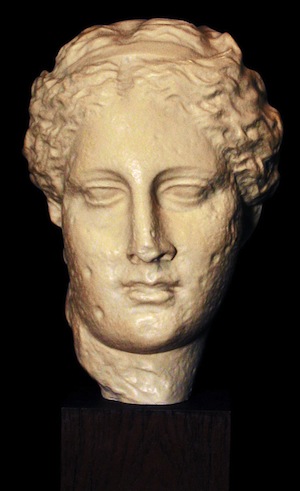Classical Greek Sculpture

Head of Hygieia or Atalanta
Classical Greek
replica: from the Louvre, Paris
date of the original: c. 350 BC
provenance of the original: the Temple of Alea Athena, Piali (ancient Tegea), Greece; excavated by Mendel (AD 1900-1902); now in the National Museum, Athens
description: Head of a goddess, either Hygieia, daughter of Asklepios, or Atalanta. In the style of Scopas. Resin replica; marble original. On base: height 40 cm, width 22 cm, depth 26 cm.
The evolution of Greek sculpture was, of course, of much greater complexity than can be described here, and was not linear, as this necessarily simplified presentation might indicate. Scopas of Paros, the author of Hygieia, is one sculptor who does not quite fit into the general scheme. He was a generation younger than Pheidias (see:Parthenon Frieze Panels) , and together with the later sculptor Praxiteles (see: Aphrodite of Cnidos; Aphrodite of Arles; Hermes and the Infant Dionysus; Apollo Lykeios), these three compose the great artistic triad of the fifth and fourth centuries. Scopas was active at Tegea in Arcadia in the Peloponnesus around 370 BC as architect in charge of the construction of the temple dedicated to Athena as well as of its sculptural decor. Curiously, not only did he hold the same position as Pheidias at Athens, but there is also little direct evidence of his work.
Nevertheless, at Tegea everything bears the same stamp and we can be sure that it reflects the master’s manner. He breaks with what we usually assume to be the “serenity” of Classicism, especially in the Tegean pedimental sculpture, which teems with orgiastic, dishevelled maenads. Scopas’ dynamic figures already merge into naturalism and point further to Hellenism. Scopas is an “irregular” in the supposed evolution of Greek art, which our wishful thinking conceives as a regular, practically predetermined process admitting no deviations.
Scholars who classify Scopas only as a sculptor of Dionysian themes identify this head as that of Atalanta, a cruel sacrificer of suitors. Others see Classical serenity in it and identify it as the head of Hygieia, a virgin addressed as “mother most high” and mentioned by Pausanias as shown together with a sculpture of her father Asklepios on the same spot at Tegea.
This head, like Scopas’ others (see: Psyche of Capua; Head of Hypnos), expresses a great deal of character and does not correspond to the somewhat vacuous Classical ideal. The beauty of Hygieia results from the finesse of her narrow face and her deep-seated melancholy eyes.